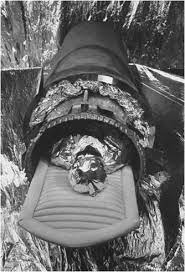The Frozen Man Who Waited for a Miracle: The Story of James Hiram Bedford
For over 50 years, the world has waited for a breakthrough in cryonics, the controversial practice of freezing the body of a deceased person in the hope of future revival.
One of the most compelling cases in this ongoing mystery is that of James Hiram Bedford, the man who made history as the first person to be cryonically preserved with the explicit promise of being revived. The year 2017, the date he was told he would awaken, has come and gone. So, what has happened to Bedford, and does modern science hold the key to bringing the dead back to life?

The Hope for Immortality:
James Hiram Bedford was a psychology professor at the University of California and a veteran of World War I. A man of diverse interests, he lived an adventurous life, traveling the globe and experiencing some of its most remote and fascinating regions, including Africa, the Amazon rainforest, and the streets of ancient European cities. He even hunted in the wilds of Africa and was one of the first to drive the Alcan Highway to the far reaches of Canada and Alaska. But in 1967, his life took an unexpected turn.
Bedford was diagnosed with terminal kidney cancer, which had spread to his lungs. Given the limited medical technology of the time, doctors informed him that he had little time to live. But rather than resigning to his fate, Bedford discovered an idea that would change the course of his life—and death.

He came across Dr. Robert Ettinger’s book, The Prospect of Immortality, which introduced the concept of cryonics—the practice of freezing the human body in the hope that future scientific advances could bring it back to life. Ettinger, often referred to as the “father of cryonics,” was the founder of the Cryonics Institute. Inspired by the idea, Bedford made a bold decision: he volunteered to be frozen after his death with the hope that one day he could be revived and given a second chance at life.
The Freezing Process:
On January 12, 1967, at the age of 73, Bedford passed away from his illness. But his journey was far from over. Bedford had made arrangements with a group of scientists, led by Robert Nelson, who was the first to perform cryonic preservation on Bedford’s body.
After his death, Bedford’s body was carefully treated. His blood was drained, and dimethyl sulfoxide—a chemical used to prevent ice crystals from forming within the cells—was injected into his body to protect his organs. Following this, Bedford’s body was placed in a liquid nitrogen tank at a chilling temperature of minus 196 degrees Celsius, effectively freezing him in time.
Bedford left behind a sum of over $100,000 (equivalent to more than 2 billion VND) to cover the costs of his cryonic preservation, hoping that someday, the technology would advance enough to bring him back to life.
The Revival Promise:

James Bedford’s case was unique not only because of his pioneering role in cryonics but also because of the promise made to him. Bedford’s cryonics procedure was expected to lead to revival in 2017, a date that has now passed. The question that everyone has been asking for decades is: Can a person be brought back to life after being frozen for so long?
In 1991, Alcor, the cryonics company now responsible for Bedford’s preservation, decided to check on the state of his body after 24 years. When they opened the cryogenic container, they found Bedford’s body in relatively good condition. He was wrapped in a pale blue sleeping bag and was kept in a nylon strap. The technicians at Alcor noted that his face looked younger than his 73 years, though there were some signs of dehydration and tissue damage, such as discolored skin on his chest and neck, and cracks in the skin’s surface.
Despite the damage, Bedford’s preservation was considered good given the extreme conditions he had been subjected to. His eyes were half-open, and his corneas had the chalky white color of ice, but overall, his body had withstood the freezing process well. Technicians rewrapped Bedford in a new sleeping bag and returned him to a liquid nitrogen tank to continue his frozen state.
The Mysterious Status:
Now, more than 50 years after Bedford’s death, his body still remains frozen in cryonic suspension, alongside 145 other bodies at the Alcor facility. 2017—the promised year of revival—has come and gone, and yet, Bedford remains a frozen figure, a symbol of both hope and mystery. Has science made the miraculous breakthrough required to revive those who are cryonically preserved, or is this merely an unrealistic dream?
As of now, there’s still no concrete evidence that cryonics can bring someone back to life. The technology necessary to revive a human body after decades of freezing has not yet materialized, and experts remain divided on whether it’s even scientifically possible. Furthermore, reanimating a body after such extensive freezing would require not only advancements in medical technology but also an ability to repair cellular damage caused by freezing, a challenge that scientists are still far from solving.
James Bedford’s story raises important questions about life, death, and the possibilities of human immortality. While his case continues to stir curiosity and skepticism, it remains one of the most fascinating examples of humanity’s quest for life beyond death.
James Hiram Bedford’s legacy as the first person to undergo cryonic preservation has made him a key figure in the cryonics movement. But whether or not he will ever be revived remains uncertain. As technology progresses, we may one day unlock the secrets of bringing frozen bodies back to life—but for now, James Bedford remains in a state of suspended animation, awaiting a miracle that may—or may not—ever happen.
For those who believe in the promise of cryonics, Bedford’s story is a symbol of hope. For skeptics, it serves as a reminder that some of the greatest mysteries of life—and death—may be beyond our reach.

